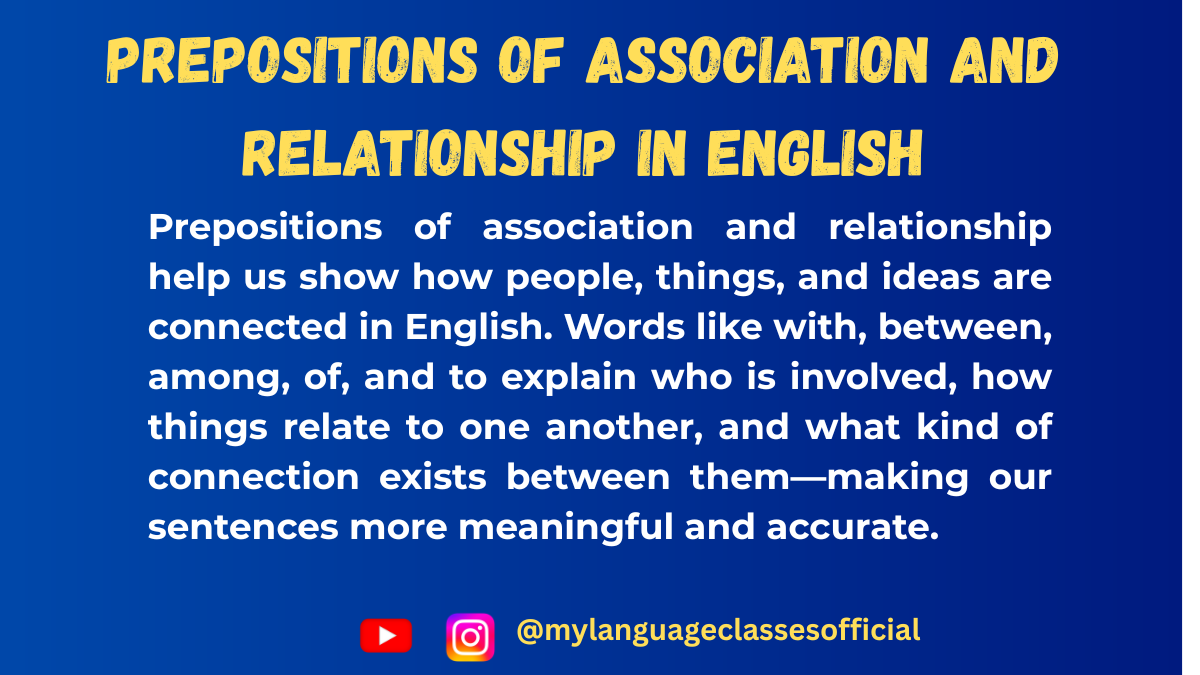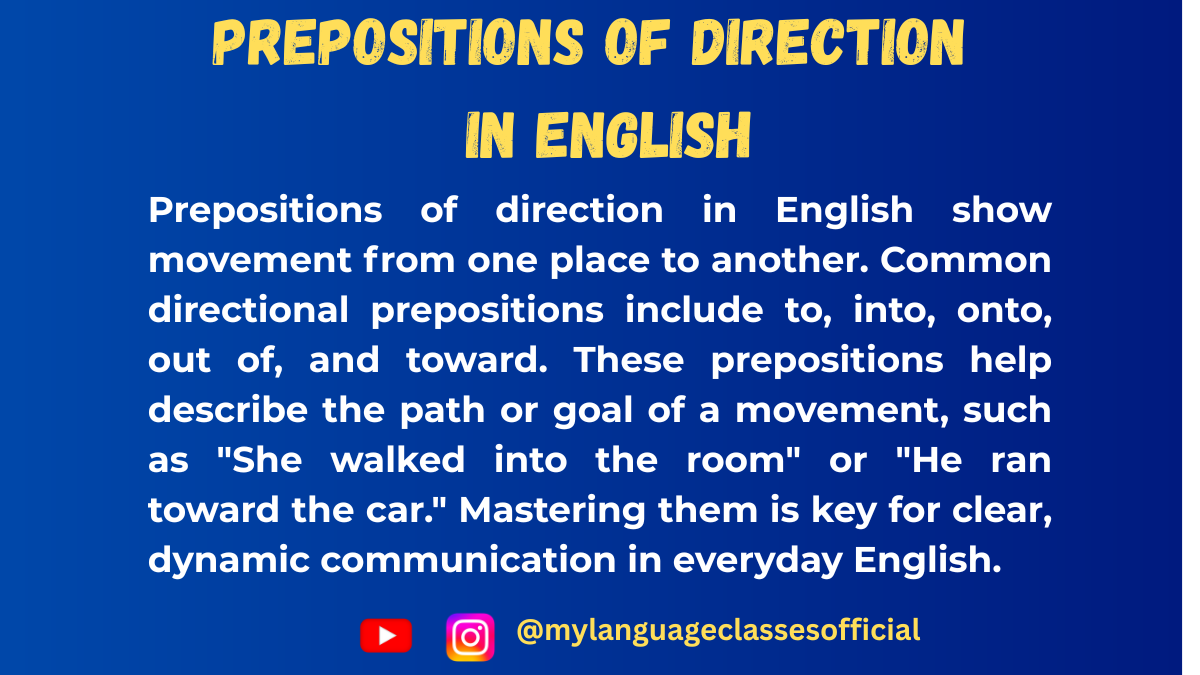Your cart is currently empty!
Tag: learn English prepositions
-

Preposition of Association and Relationship in English
Prepositions are small but mighty words that play a crucial role in connecting ideas and providing context in sentences. Among the various types of prepositions, Prepositions of Association and Relationship are particularly important because they help us describe how people, things, or ideas are connected. In this blog post, we’ll explore the usage of these prepositions in detail, provide examples, and offer practical exercises to help you master them.
What Are Prepositions of Association and Relationship?
Prepositions of Association and Relationship are used to indicate a connection or relationship between two or more entities. These prepositions help clarify how people, objects, or concepts are linked, whether through partnership, belonging, or interaction.
Usage of Prepositions of Association and Relationship
These prepositions are used in various contexts, including:
- Partnerships and Collaborations: To describe working or being together.
- Example: She works with a team of experts.
- Ownership or Belonging: To show possession or association.
- Example: This is the book of my friend.
- Relationships Between People: To describe familial, romantic, or social connections.
- Example: He is married to Sarah.
- Connections Between Objects or Ideas: To explain how things are related.
- Example: The key to success is hard work.
- Membership or Inclusion: To indicate being part of a group.
- Example: She is a member of the club.
- Origin or Source: To show where something or someone comes from.
- Example: This gift is from my grandmother.
List of Prepositions of Association and Relationship
Here’s a table of common prepositions of association and relationship, along with example sentences:
Preposition Example Sentences With 1. She went to the party with her friends.
2. He is collaborating with a renowned scientist.Of 1. The color of the sky is blue.
2. This is a picture of my family.To 1. She is married to a doctor.
2. The answer to the question is simple.From 1. This letter is from my teacher.
2. He hails from a small village.For 1. This gift is for you.
2. She has a deep love for animals.About 1. They were talking about the project.
2. This book is about ancient history.Among 1. The secret was shared among friends.
2. She was among the top performers.Between 1. The agreement between the two companies was signed.
2. The conversation between them was intense.By 1. The book was written by a famous author.
2. The painting was created by an artist.Against 1. She leaned against the wall.
2. The decision was against his wishes.
More Example Sentences
- She is always with her best friend.
- The sound of the waves is soothing.
- He is loyal to his team.
- This recipe is from my grandmother.
- I bought a gift for my sister.
- They were arguing about the rules.
- The prize was divided among the winners.
- There is a strong bond between the twins.
- The song was composed by a talented musician.
- The protest was against the new policy.
Fill in the Blanks
Test your understanding by filling in the blanks with the correct preposition of association and relationship:
- She is traveling ___ her colleagues.
- This is a photo ___ my childhood.
- He is always kind ___ animals.
- The letter was ___ the manager.
- The discussion was ___ the new project.
- The cake was shared ___ the children.
- The agreement ___ the two parties was finalized.
- The novel was written ___ a famous author.
- She stood ___ the door, waiting for him.
- The decision was ___ his will.
Answers to Fill in the Blanks
- with
- of
- to
- from
- about
- among
- between
- by
- against
- against
Things to Keep in Mind
- Articles and Gender: Prepositions of association and relationship are not affected by gender or articles. They remain the same regardless of whether the noun is masculine, feminine, singular, or plural.
- Example: with the boy, with the girl, with the books.
- Context Matters: The choice of preposition depends on the context of the sentence. For example, with is used for companionship, while of is used for possession.
- Avoid Overusing Prepositions: While prepositions are essential, overusing them can make sentences clunky. Ensure each preposition adds value to the sentence.
- Practice Regularly: The more you practice, the more natural using these prepositions will become.
Conclusion
Prepositions of Association and Relationship are indispensable tools for expressing connections and relationships in English. By understanding their usage and practicing regularly, you can enhance your communication skills and write or speak more effectively. Remember to pay attention to context and keep practicing with examples and exercises.
If you enjoyed this lesson, be sure to check out more posts like this on my blog at My Language Classes. Don’t forget to subscribe my YouTube channel and follow me on Instagram for the latest language learning tips and lessons. Leave a comment below to share your thoughts, or ask any questions you have about nouns.
Happy learning! 😊
- Partnerships and Collaborations: To describe working or being together.
-

Prepositions of Direction in English
Prepositions of direction indicate movement from one place to another. They are essential in describing how something moves or changes position concerning another object.
List of Prepositions of Direction and Their Usage
Preposition Meaning Example Sentence 1 Example Sentence 2 To Movement towards a destination She went to the park. He sent a letter to his friend. Into Movement from outside to inside She walked into the room. The cat jumped into the box. Onto Movement towards a surface The child climbed onto the table. He jumped onto the bed. Out of Movement from inside to outside She ran out of the house. He took his phone out of his pocket. Towards Movement in the direction of something She moved towards the door. He walked towards me with a smile. Away from Movement in the opposite direction She walked away from the fire. The dog ran away from the stranger. Up Movement from a lower position to a higher one He climbed up the hill. The plane soared up into the sky. Down Movement from a higher position to a lower one The ball rolled down the hill. She walked down the stairs. Across Movement from one side to another He swam across the river. The children ran across the street. Over Movement above something The bird flew over the lake. He jumped over the fence. Under Movement beneath something The dog crawled under the table. The ball rolled under the chair. Along Movement following a path He walked along the beach. The car drove along the highway. Past Movement beyond a certain point They walked past the school. He drove past the mall. Through Movement within a space from one end to another She ran through the tunnel. The wind blew through the trees. Around Movement in a circular direction He walked around the park. The car drove around the roundabout.
More Example Sentences
- The boy ran to his mother as soon as he saw her.
- She poured the coffee into the cup carefully.
- He jumped onto the boat from the dock.
- The cat ran out of the house when the door was open.
- The athlete sprinted towards the finish line.
- They moved away from the dangerous area.
- The monkey climbed up the tree quickly.
- She walked down the street, enjoying the fresh air.
- He drove across the city to meet his friend.
- The plane flew over the mountains.
Fill in the Blanks
- She jumped ___ the swimming pool.
- He walked ___ the tunnel to reach the other side.
- The dog ran ___ the street to chase the cat.
- The helicopter flew ___ the buildings.
- He climbed ___ the ladder to fix the roof.
- The train passed ___ the bridge.
- The girl moved ___ the stage to receive her award.
- The kids walked ___ the road to reach school.
- The car drove ___ the highway without stopping.
- He ran ___ the hill with great speed.
Answers:
- into
- through
- across
- over
- up
- over
- towards
- across
- along
- down
Things to Keep in Mind
- Prepositions of direction always describe movement from one place to another.
- Some prepositions like to and towards may seem similar but have different uses (e.g., “to” specifies the destination, while “towards” indicates movement in a direction without necessarily reaching the destination).
- Prepositions such as into and onto describe entering or moving onto a surface, while in and on describe static positions.
- Over and under describe movement above and below something, respectively.
- Across and through both describe movement, but “across” is typically for flat surfaces, while “through” indicates movement within an enclosed space.
Conclusion
Prepositions of direction are essential for clear communication when describing movement and changes in position. Understanding their proper usage will enhance both written and spoken English. By practicing these prepositions in different contexts, you can develop a natural sense of their application and improve your fluency. Keep practicing with more sentences and exercises to master this important grammar topic!
If you enjoyed this lesson, be sure to check out more posts like this on my blog at My Language Classes. Don’t forget to subscribe my YouTube channel and follow me on Instagram for the latest language learning tips and lessons. Leave a comment below to share your thoughts, or ask any questions you have about nouns.
Happy learning! 😊

